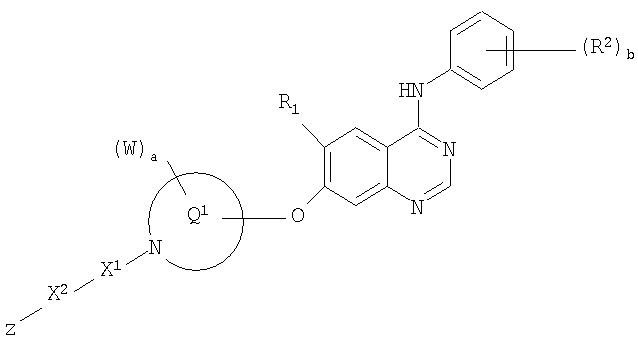FIELD: chemistry.
SUBSTANCE: invention relates to novel quinoline derivatives of formula I or pharmaceutically acceptable salts thereof or esters with tyrosine kinase inhibitor properties. In formula I  , R1 is selected from hydroxy, C1-C4-alkoxy, hydroxy(C2-C4-alkoxy), C1-C3-alkoxy-(C2-C4-alkoxy) or from a group of formula Q2-X3 - in which X3 is O, and Q2 is azetidin-1-yl-C2-C4-alkyl, pyrrolidin-1-yl- C2-C4-alkyl, piperidino-C2-C4-alkyl, piperazino-C2-C4-alkyl or morpholino-C2-C4-alkyl; b is 1, 2, or 3; each R2, which can be identical or different, is selected from fluorine, chlorine, bromine, C1-C4-alkyl, C2-C4-alkenyl and C2-C4-alkenyl; Q1 is piperidinyl; a is 0; X1 is CO; X2 is a group of formula: -(CR12R13)P-(Q5)m-, where m is 0 or 1, p is 0, 1, 2, 3 or 4; each of R12 and R13, which can be identical or different, is selected from hydrogen, C1-C6-alkyl, amino, C1-C6-alkylamino and di-[C1-C6-alkyl]amino, and Q5 is C3-C7cycloalkylene; Z is selected from hydroxy, amino, C1-C6-alkylamino, di-[C1-C6-alkyl]amino, C1-C6-alkoxy and a group of formula: Q6-X9-, in which X9 is a single bond and Q6 is heterocyclyl or heterocyclyl-C1-C4 alkyl; under the condition that, if m and p are equal to 0, Z is heterocyclyl.
, R1 is selected from hydroxy, C1-C4-alkoxy, hydroxy(C2-C4-alkoxy), C1-C3-alkoxy-(C2-C4-alkoxy) or from a group of formula Q2-X3 - in which X3 is O, and Q2 is azetidin-1-yl-C2-C4-alkyl, pyrrolidin-1-yl- C2-C4-alkyl, piperidino-C2-C4-alkyl, piperazino-C2-C4-alkyl or morpholino-C2-C4-alkyl; b is 1, 2, or 3; each R2, which can be identical or different, is selected from fluorine, chlorine, bromine, C1-C4-alkyl, C2-C4-alkenyl and C2-C4-alkenyl; Q1 is piperidinyl; a is 0; X1 is CO; X2 is a group of formula: -(CR12R13)P-(Q5)m-, where m is 0 or 1, p is 0, 1, 2, 3 or 4; each of R12 and R13, which can be identical or different, is selected from hydrogen, C1-C6-alkyl, amino, C1-C6-alkylamino and di-[C1-C6-alkyl]amino, and Q5 is C3-C7cycloalkylene; Z is selected from hydroxy, amino, C1-C6-alkylamino, di-[C1-C6-alkyl]amino, C1-C6-alkoxy and a group of formula: Q6-X9-, in which X9 is a single bond and Q6 is heterocyclyl or heterocyclyl-C1-C4 alkyl; under the condition that, if m and p are equal to 0, Z is heterocyclyl.
EFFECT: proposed derivatives can be used in treating proliferative diseases, particularly for treating malignant growths.
32 cl, 4 dwg, 2 tbl, 37 ex
Authors
Dates
2010-01-10—Published
2004-09-13—Filed